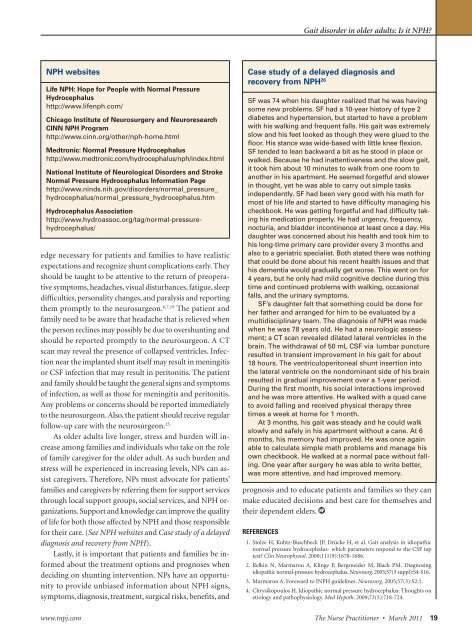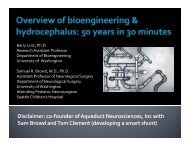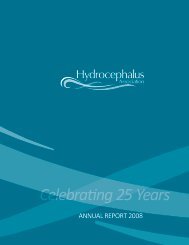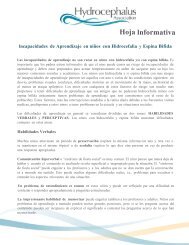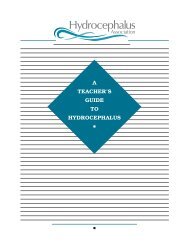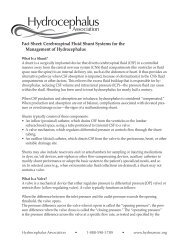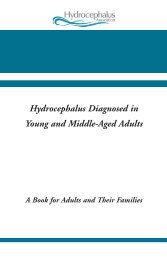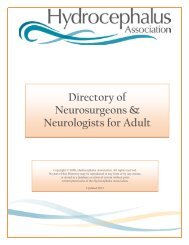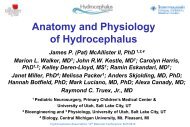Gait disorder in older adults: Is it NPH? - ResearchGate
Gait disorder in older adults: Is it NPH? - ResearchGate
Gait disorder in older adults: Is it NPH? - ResearchGate
Create successful ePaper yourself
Turn your PDF publications into a flip-book with our unique Google optimized e-Paper software.
<strong>Ga<strong>it</strong></strong> <strong>disorder</strong> <strong>in</strong> <strong>older</strong> <strong>adults</strong>: <strong>Is</strong> <strong>it</strong> <strong>NPH</strong>?<br />
<strong>NPH</strong> webs<strong>it</strong>es<br />
Life <strong>NPH</strong>: Hope for People w<strong>it</strong>h Normal Pressure<br />
Hydrocephalus<br />
http://www.lifenph.com/<br />
Chicago Inst<strong>it</strong>ute of Neurosurgery and Neuroresearch<br />
CINN <strong>NPH</strong> Program<br />
http://www.c<strong>in</strong>n.org/other/nph-home.html<br />
Medtronic: Normal Pressure Hydrocephalus<br />
http://www.medtronic.com/hydrocephalus/nph/<strong>in</strong>dex.html<br />
National Inst<strong>it</strong>ute of Neurological Disorders and Stroke<br />
Normal Pressure Hydrocephalus Information Page<br />
http://www.n<strong>in</strong>ds.nih.gov/<strong>disorder</strong>s/normal_pressure_<br />
hydrocephalus/normal_pressure_hydrocephalus.htm<br />
Hydrocephalus Association<br />
http://www.hydroassoc.org/tag/normal-pressurehydrocephalus/<br />
edge necessary for patients and families to have realistic<br />
expectations and recognize shunt complications early. They<br />
should be taught to be attentive to the return of preoperative<br />
symptoms, headaches, visual disturbances, fatigue, sleep<br />
difficulties, personal<strong>it</strong>y changes, and paralysis and report<strong>in</strong>g<br />
them promptly to the neurosurgeon. 6,7,19 The patient and<br />
family need to be aware that headache that is relieved when<br />
the person recl<strong>in</strong>es may possibly be due to overshunt<strong>in</strong>g and<br />
should be reported promptly to the neurosurgeon. A CT<br />
scan may reveal the presence of collapsed ventricles. Infection<br />
near the implanted shunt <strong>it</strong>self may result <strong>in</strong> men<strong>in</strong>g<strong>it</strong>is<br />
or CSF <strong>in</strong>fection that may result <strong>in</strong> per<strong>it</strong>on<strong>it</strong>is. The patient<br />
and family should be taught the general signs and symptoms<br />
of <strong>in</strong>fection, as well as those for men<strong>in</strong>g<strong>it</strong>is and per<strong>it</strong>on<strong>it</strong>is.<br />
Any problems or concerns should be reported immediately<br />
to the neurosurgeon. Also, the patient should receive regular<br />
follow-up care w<strong>it</strong>h the neurosurgeon. 25<br />
As <strong>older</strong> <strong>adults</strong> live longer, stress and burden will <strong>in</strong>crease<br />
among families and <strong>in</strong>dividuals who take on the role<br />
of family caregiver for the <strong>older</strong> adult. As such burden and<br />
stress will be experienced <strong>in</strong> <strong>in</strong>creas<strong>in</strong>g levels, NPs can assist<br />
caregivers. Therefore, NPs must advocate for patients’<br />
families and caregivers by referr<strong>in</strong>g them for support services<br />
through local support groups, social services, and <strong>NPH</strong> organizations.<br />
Support and knowledge can improve the qual<strong>it</strong>y<br />
of life for both those affected by <strong>NPH</strong> and those responsible<br />
for their care. (See <strong>NPH</strong> webs<strong>it</strong>es and Case study of a delayed<br />
diagnosis and recovery from <strong>NPH</strong>).<br />
Lastly, <strong>it</strong> is important that patients and families be <strong>in</strong>formed<br />
about the treatment options and prognoses when<br />
decid<strong>in</strong>g on shunt<strong>in</strong>g <strong>in</strong>tervention. NPs have an opportun<strong>it</strong>y<br />
to provide unbiased <strong>in</strong>formation about <strong>NPH</strong> signs,<br />
symptoms, diagnosis, treatment, surgical risks, benef<strong>it</strong>s, and<br />
Case study of a delayed diagnosis and<br />
recovery from <strong>NPH</strong> 26<br />
SF was 74 when his daughter realized that he was hav<strong>in</strong>g<br />
some new problems. SF had a 10-year history of type 2<br />
diabetes and hypertension, but started to have a problem<br />
w<strong>it</strong>h his walk<strong>in</strong>g and frequent falls. His ga<strong>it</strong> was extremely<br />
slow and his feet looked as though they were glued to the<br />
floor. His stance was wide-based w<strong>it</strong>h l<strong>it</strong>tle knee flexion.<br />
SF tended to lean backward a b<strong>it</strong> as he stood <strong>in</strong> place or<br />
walked. Because he had <strong>in</strong>attentiveness and the slow ga<strong>it</strong>,<br />
<strong>it</strong> took him about 10 m<strong>in</strong>utes to walk from one room to<br />
another <strong>in</strong> his apartment. He seemed forge tful and slower<br />
<strong>in</strong> thought, yet he was able to carry out simple tasks<br />
<strong>in</strong>dependently. SF had been very good w<strong>it</strong>h his math for<br />
most of his life and started to have difficulty manag<strong>in</strong>g his<br />
checkbook. He was gett<strong>in</strong>g forgetful and had difficulty tak<strong>in</strong>g<br />
his medication properly. He had urgency, frequency,<br />
nocturia, and bladder <strong>in</strong>cont<strong>in</strong>ence at least once a day. His<br />
daughter was concerned about his health and took him to<br />
his long-time primary care provider every 3 months and<br />
also to a geriatric specialist. Both stated there was noth<strong>in</strong>g<br />
that could be done about his recent health issues and that<br />
his dementia would gradually get worse. This went on for<br />
4 years, but he only had mild cogn<strong>it</strong>ive decl<strong>in</strong>e dur<strong>in</strong>g this<br />
time and cont<strong>in</strong>ued problems w<strong>it</strong>h walk<strong>in</strong>g, occasional<br />
falls, and the ur<strong>in</strong>ary symptoms.<br />
SF’s daughter felt that someth<strong>in</strong>g could be done for<br />
her father and arranged for him to be evaluated by a<br />
multidiscipl<strong>in</strong>ary team. The diagnosis of <strong>NPH</strong> was made<br />
when he was 78 years old. He had a neurologic assessment;<br />
a CT scan revealed dilated lateral ventricles <strong>in</strong> the<br />
bra<strong>in</strong>. The w<strong>it</strong>hdrawal of 50 mL CSF via lumbar puncture<br />
resulted <strong>in</strong> transient improvement <strong>in</strong> his ga<strong>it</strong> for about<br />
18 hours. The ventriculoper<strong>it</strong>oneal shunt <strong>in</strong>sertion <strong>in</strong>to<br />
the lateral ventricle on the nondom<strong>in</strong>ant side of his bra<strong>in</strong><br />
resulted <strong>in</strong> gradual improvement over a 1-year period.<br />
Dur<strong>in</strong>g the first month, his social <strong>in</strong>teractions improved<br />
and he was more attentive. He walked w<strong>it</strong>h a quad cane<br />
to avoid fall<strong>in</strong>g and received physical therapy three<br />
times a week at home for 1 month.<br />
At 3 months, his ga<strong>it</strong> was steady and he could walk<br />
slowly and safely <strong>in</strong> his apartment w<strong>it</strong>hout a cane. At 6<br />
months, his memory had improved. He was once aga<strong>in</strong><br />
able to calculate simple math problems and manage his<br />
own checkbook. He walked at a normal pace w<strong>it</strong>hout fall<strong>in</strong>g.<br />
One year after surgery he was able to wr<strong>it</strong>e better,<br />
was more attentive, and had improved memory.<br />
prognosis and to educate patients and families so they can<br />
make educated decisions and best care for themselves and<br />
their dependent elders.<br />
REFERENCES<br />
1. Stolze H, Kuhtz-Buschbeck JP, Drücke H, et al. <strong>Ga<strong>it</strong></strong> analysis <strong>in</strong> idiopathic<br />
normal pressure hydrocephalus- which parameters respond to the CSF tap<br />
test? Cl<strong>in</strong> Neurophysiol. 2000;111(9):1678-1686.<br />
2. Relk<strong>in</strong> N, Marmarou A, Kl<strong>in</strong>ge P, Bergsneider M, Black PM. Diagnos<strong>in</strong>g<br />
idiopathic normal-pressure hydrocephalus. Neurosurg. 2005;57(3 suppl):S4-S16.<br />
3. Marmarou A. Foreward to I<strong>NPH</strong> guidel<strong>in</strong>es. Neurosurg. 2005;57(3):S2:1.<br />
4. Chrysikopoulos H. Idiopathic normal pressure hydrocephalus: Thoughts on<br />
etiology and pathophysiology. Med Hypoth. 2009;73(5):718-724.<br />
www.tnpj.com The Nurse Pract<strong>it</strong>ioner • March 2011 19<br />
Copyright © 2011 Lipp<strong>in</strong>cott Williams & Wilk<strong>in</strong>s. Unauthorized reproduction of this article is prohib<strong>it</strong>ed.


